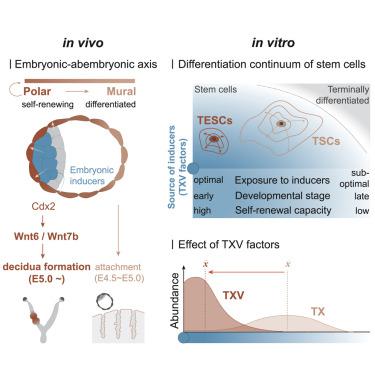Cell Stem Cell ( IF 19.8 ) Pub Date : 2022-07-07 , DOI: 10.1016/j.stem.2022.06.002 Jinwoo Seong 1 , Javier Frias-Aldeguer 2 , Viktoria Holzmann 1 , Harunobu Kagawa 1 , Giovanni Sestini 1 , Heidar Heidari Khoei 3 , Yvonne Scholte Op Reimer 1 , Maarten Kip 4 , Saurabh J Pradhan 1 , Lucas Verwegen 5 , Judith Vivié 4 , Linfeng Li 6 , Anna Alemany 4 , Jeroen Korving 4 , Frank Darmis 4 , Alexander van Oudenaarden 4 , Derk Ten Berge 5 , Niels Geijsen 7 , Nicolas C Rivron 8

|
The embryo instructs the allocation of cell states to spatially regulate functions. In the blastocyst, patterning of trophoblast (TR) cells ensures successful implantation and placental development. Here, we defined an optimal set of molecules secreted by the epiblast (inducers) that captures in vitro stable, highly self-renewing mouse trophectoderm stem cells (TESCs) resembling the blastocyst stage. When exposed to suboptimal inducers, these stem cells fluctuate to form interconvertible subpopulations with reduced self-renewal and facilitated differentiation, resembling peri-implantation cells, known as TR stem cells (TSCs). TESCs have enhanced capacity to form blastoids that implant more efficiently in utero due to inducers maintaining not only local TR proliferation and self-renewal, but also WNT6/7B secretion that stimulates uterine decidualization. Overall, the epiblast maintains sustained growth and decidualization potential of abutting TR cells, while, as known, distancing imposed by the blastocyst cavity differentiates TR cells for uterus adhesion, thus patterning the essential functions of implantation.
中文翻译:

外胚层诱导剂在体外捕获小鼠滋养外胚层干细胞并形成胚状体以在子宫内植入
胚胎指示细胞状态的分配以在空间上调节功能。在胚泡中,滋养层 (TR) 细胞的模式可确保成功植入和胎盘发育。在这里,我们定义了一组由外胚层(诱导剂)分泌的最佳分子,这些分子在体外捕获类似于囊胚阶段的稳定、高度自我更新的小鼠滋养外胚层干细胞 (TESCs)。当暴露于次优诱导剂时,这些干细胞会波动形成可相互转化的亚群,其自我更新减少并促进分化,类似于植入周围细胞,称为 TR 干细胞 (TSC)。TESCs 增强了形成胚状体的能力,可以更有效地在子宫内植入由于诱导剂不仅维持局部 TR 增殖和自我更新,而且维持刺激子宫蜕膜化的 WNT6/7B 分泌。总体而言,外胚层保持邻近 TR 细胞的持续生长和蜕膜潜力,而众所周知,胚泡腔施加的距离使 TR 细胞分化为子宫粘附,从而形成了植入的基本功能。











































 京公网安备 11010802027423号
京公网安备 11010802027423号